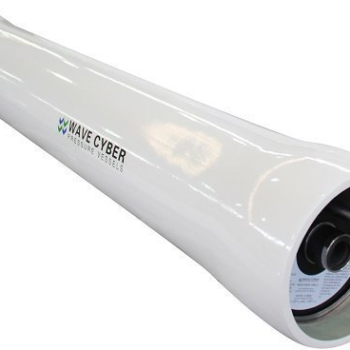MEMBRANEOUS HOUSINGS
Membrane housings in industrial reverse osmosis (RO) systems play a critical role in supporting and protecting the membranes, which are key components of the water purification process.
These enclosures are designed to securely hold multiple reverse osmosis membrane elements while allowing water to flow through the membranes for filtration.
Choosing the right membrane housing has an impact on ensuring the efficiency, reliability and longevity of the reverse osmosis system.
-
Membrane housings
Wave Cyber Wave-300E- 8040-1 housing for membranes 8″ 300 psi End Port
748 $ Add to cart -
Membrane housings
Wave Cyber Wave-300E- 8080-2 housing for membranes 8″ 300 psi End Port
783 $ Add to cart
Here is a brief description of membrane enclosures, their selection and their importance:
Membrane Enclosure Components and Characteristics:
- Membrane enclosures are typically made of materials that are resistant to the chemicals and pressures present in reverse osmosis systems. Common materials include fiberglass reinforced plastic (FRP), stainless steel.
Material selection depends on factors such as operating environment, chemical compatibility, and budget. - Diaphragm housings are available in a variety of configurations, including pressure vessels and diaphragm racks. Pressure vessels are cylindrical containers containing multiple membrane elements. Membrane racks are designed to house individual membrane elements in a horizontal or vertical arrangement.
- The housings must provide effective sealing to prevent leaks and ensure proper pressurization within the system. This includes gaskets, O-rings, and locking mechanisms that reliably seal the enclosure.
- Enclosures are rated for certain pressure levels. The pressure rating must match the operating pressure of the reverse osmosis system to prevent structural failure or leaks.
- Enclosures have inlet and outlet ports for water flow. These connections must match the system piping and provide the required flow rate.
- The number of reverse osmosis membrane elements the enclosure can accommodate depends on the size of the enclosure and the size of the membrane elements. The design of the enclosure must provide proper spacing between elements for efficient water flow and maintenance.
- Enclosures should be designed to allow easy access and maintenance of the membrane elements. Quick-opening closures or easily removable end caps facilitate membrane replacement and cleaning.
The following criteria should be considered when selecting membrane housings:
- The capacity of the enclosure should match the desired water production rate of the reverse osmosis system. Consider the number of membrane elements required to achieve the desired production rate.
- Consider the temperature, pressure, and chemical composition of the feed water. Select enclosure materials and designs that can withstand these conditions without degradation.
- Select enclosures that allow for easy maintenance and replacement of diaphragm elements. Quick-opening lids or designs with removable end caps can save time during maintenance.
- Ensure that connections and enclosure design are compatible with the rest of the reverse osmosis system, including pumps, piping, and instrumentation.
In industrial reverse osmosis systems, membrane housings are an important part of the installation. They not only protect the sensitive RO membranes but also affect the overall efficiency and performance of the water purification process. Selecting the right membrane enclosure involves considering factors such as capacity, operating conditions, maintenance, and compatibility to ensure the success of the reverse osmosis system.
own enterprise
customized solutions
operational experience
and installation









